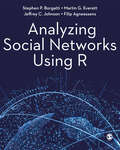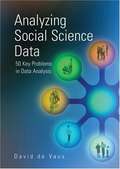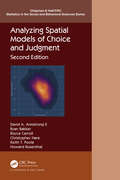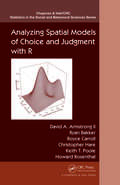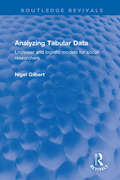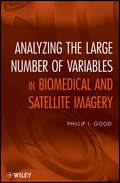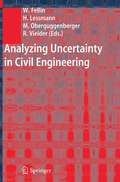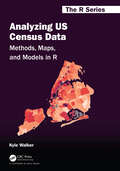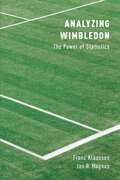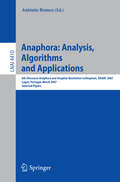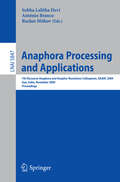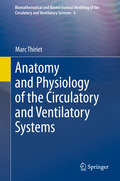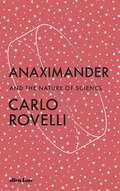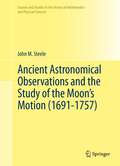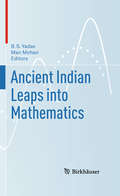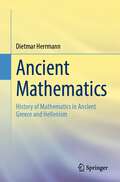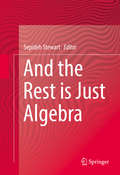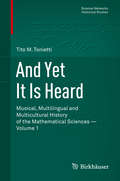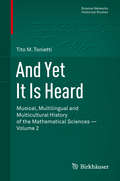- Table View
- List View
Analyzing Social Networks Using R
by Stephen P. Borgatti Martin G. Everett Jeffrey C. Johnson Filip AgneessensThis approachable book introduces network research in R, walking you through every step of doing social network analysis. Drawing together research design, data collection and data analysis, it explains the core concepts of network analysis in a non-technical way. The book balances an easy to follow explanation of the theoretical and statistical foundations underpinning network analysis with practical guidance on key steps like data management, preparation and visualisation. With clarity and expert insight, it: • Discusses measures and techniques for analyzing social network data, including digital media • Explains a range of statistical models including QAP and ERGM, giving you the tools to approach different types of networks • Offers digital resources like practice datasets and worked examples that help you get to grips with R software
Analyzing Social Networks Using R
by Stephen P. Borgatti Martin G. Everett Jeffrey C. Johnson Filip AgneessensThis approachable book introduces network research in R, walking you through every step of doing social network analysis. Drawing together research design, data collection and data analysis, it explains the core concepts of network analysis in a non-technical way. The book balances an easy to follow explanation of the theoretical and statistical foundations underpinning network analysis with practical guidance on key steps like data management, preparation and visualisation. With clarity and expert insight, it: • Discusses measures and techniques for analyzing social network data, including digital media • Explains a range of statistical models including QAP and ERGM, giving you the tools to approach different types of networks • Offers digital resources like practice datasets and worked examples that help you get to grips with R software
Analyzing Social Networks Using R
by Stephen P. Borgatti Martin G. Everett Jeffrey C. Johnson Filip AgneessensThis approachable book introduces network research in R, walking you through every step of doing social network analysis. Drawing together research design, data collection and data analysis, it explains the core concepts of network analysis in a non-technical way. The book balances an easy to follow explanation of the theoretical and statistical foundations underpinning network analysis with practical guidance on key steps like data management, preparation and visualisation. With clarity and expert insight, it: • Discusses measures and techniques for analyzing social network data, including digital media • Explains a range of statistical models including QAP and ERGM, giving you the tools to approach different types of networks • Offers digital resources like practice datasets and worked examples that help you get to grips with R software
Analyzing Social Science Data: 50 Key Problems In Data Analysis (PDF)
by David De VausIn this novel and refreshing textbook, David de Vaus directs students to the core of data analysis. The book is an authoritative guide to the problems facing beginners in the field. Analyzing Social Science Data guides students in: problems with the initial data; problems with the initial variables; how to handle too much data; how to generalize; problems of analyzing single variables; problems examining bivariate relationships; and problems examining multivariate relationships The book is a tour de force in making data analysis manageable and rewarding for today's undergraduate studying research methods. `I'm full of admiration for this book. Once again, David de Vaus has come up with a superb book that is well written and organized and which will be a boon to a wide range of students. He has taken a vast array of problems that users of quantitative data analysis procedures are likely to encounter. The selection of issues and problems . . . reflects the experience of a true practitioner with a grasp of his field and of the intricacies of the research process. The selection of issues clearly derives also from experience of teaching students how to do research and analyse data. . . . A large number of practitioners will want the book. I was surprised at how much I learned from this. This will be a vital book for the bookshelves of practitioners of the craft of quantitative data analysis' - Alan Bryman, Professor of Social Research, Loughborough University
Analyzing Spatial Models of Choice and Judgment (Chapman & Hall/CRC Statistics in the Social and Behavioral Sciences)
by David A. Armstrong Ryan Bakker Royce Carroll Christopher Hare Keith T. Poole Howard RosenthalWith recent advances in computing power and the widespread availability of preference, perception and choice data, such as public opinion surveys and legislative voting, the empirical estimation of spatial models using scaling and ideal point estimation methods has never been more accessible.The second edition of Analyzing Spatial Models of Choice and Judgment demonstrates how to estimate and interpret spatial models with a variety of methods using the open-source programming language R. Requiring only basic knowledge of R, the book enables social science researchers to apply the methods to their own data. Also suitable for experienced methodologists, it presents the latest methods for modeling the distances between points. The authors explain the basic theory behind empirical spatial models, then illustrate the estimation technique behind implementing each method, exploring the advantages and limitations while providing visualizations to understand the results. This second edition updates and expands the methods and software discussed in the first edition, including new coverage of methods for ordinal data and anchoring vignettes in surveys, as well as an entire chapter dedicated to Bayesian methods. The second edition is made easier to use by the inclusion of an R package, which provides all data and functions used in the book. David A. Armstrong II is Canada Research Chair in Political Methodology and Associate Professor of Political Science at Western University. His research interests include measurement, Democracy and state repressive action. Ryan Bakker is Reader in Comparative Politics at the University of Essex. His research interests include applied Bayesian modeling, measurement, Western European politics, and EU politics. Royce Carroll is Professor in Comparative Politics at the University of Essex. His research focuses on measurement of ideology and the comparative politics of legislatures and political parties. Christopher Hare is Assistant Professor in Political Science at the University of California, Davis. His research focuses on ideology and voting behavior in US politics, political polarization, and measurement. Keith T. Poole is Philip H. Alston Jr. Distinguished Professor of Political Science at the University of Georgia. His research interests include methodology, US political-economic history, economic growth and entrepreneurship. Howard Rosenthal is Professor of Politics at NYU and Roger Williams Straus Professor of Social Sciences, Emeritus, at Princeton. Rosenthal’s research focuses on political economy, American politics and methodology.
Analyzing Spatial Models of Choice and Judgment (Chapman & Hall/CRC Statistics in the Social and Behavioral Sciences #14)
by David A. Armstrong Ryan Bakker Royce Carroll Christopher Hare Keith T. Poole Howard RosenthalWith recent advances in computing power and the widespread availability of preference, perception and choice data, such as public opinion surveys and legislative voting, the empirical estimation of spatial models using scaling and ideal point estimation methods has never been more accessible.The second edition of Analyzing Spatial Models of Choice and Judgment demonstrates how to estimate and interpret spatial models with a variety of methods using the open-source programming language R. Requiring only basic knowledge of R, the book enables social science researchers to apply the methods to their own data. Also suitable for experienced methodologists, it presents the latest methods for modeling the distances between points. The authors explain the basic theory behind empirical spatial models, then illustrate the estimation technique behind implementing each method, exploring the advantages and limitations while providing visualizations to understand the results. This second edition updates and expands the methods and software discussed in the first edition, including new coverage of methods for ordinal data and anchoring vignettes in surveys, as well as an entire chapter dedicated to Bayesian methods. The second edition is made easier to use by the inclusion of an R package, which provides all data and functions used in the book. David A. Armstrong II is Canada Research Chair in Political Methodology and Associate Professor of Political Science at Western University. His research interests include measurement, Democracy and state repressive action. Ryan Bakker is Reader in Comparative Politics at the University of Essex. His research interests include applied Bayesian modeling, measurement, Western European politics, and EU politics. Royce Carroll is Professor in Comparative Politics at the University of Essex. His research focuses on measurement of ideology and the comparative politics of legislatures and political parties. Christopher Hare is Assistant Professor in Political Science at the University of California, Davis. His research focuses on ideology and voting behavior in US politics, political polarization, and measurement. Keith T. Poole is Philip H. Alston Jr. Distinguished Professor of Political Science at the University of Georgia. His research interests include methodology, US political-economic history, economic growth and entrepreneurship. Howard Rosenthal is Professor of Politics at NYU and Roger Williams Straus Professor of Social Sciences, Emeritus, at Princeton. Rosenthal’s research focuses on political economy, American politics and methodology.
Analyzing Spatial Models of Choice and Judgment with R
by David A. Armstrong II Ryan Bakker Royce Carroll Christopher Hare Keith T. Poole Howard RosenthalModern Methods for Evaluating Your Social Science DataWith recent advances in computing power and the widespread availability of political choice data, such as legislative roll call and public opinion survey data, the empirical estimation of spatial models has never been easier or more popular. Analyzing Spatial Models of Choice and Judgment with R
Analyzing Tabular Data: Loglinear and logistic models for social researchers (Routledge Revivals)
by Nigel GilbertFirst published in 1993, Analyzing Tabular Data is an accessible text introducing a powerful range of analytical methods. Empirical social research almost invariably requires the presentation and analysis of tables, and this book is for those who have little prior knowledge of quantitative analysis or statistics, but who have a practical need to extract the most from their data. The book begins with an introduction to the process of data analysis and the basic structure of cross-tabulations. At the core of the methods described in the text is the loglinear model. This and the logistic model, are explained and their application to causal modelling, to event history analysis, and to social mobility research are described in detail. Each chapter concludes with sample programs to show how analysis on typical datasets can be carried out using either the popular computer packages, SPSS, or the statistical programme, GLIM. The book is packed with examples which apply the methods to social science research. Sociologists, geographers, psychologists, economists, market researchers and those involved in survey research in the fields of planning, evaluation and policy will find the book to be a clear and thorough exposition of methods for the analysis of tabular data.
Analyzing Tabular Data: Loglinear and logistic models for social researchers (Routledge Revivals)
by Nigel GilbertFirst published in 1993, Analyzing Tabular Data is an accessible text introducing a powerful range of analytical methods. Empirical social research almost invariably requires the presentation and analysis of tables, and this book is for those who have little prior knowledge of quantitative analysis or statistics, but who have a practical need to extract the most from their data. The book begins with an introduction to the process of data analysis and the basic structure of cross-tabulations. At the core of the methods described in the text is the loglinear model. This and the logistic model, are explained and their application to causal modelling, to event history analysis, and to social mobility research are described in detail. Each chapter concludes with sample programs to show how analysis on typical datasets can be carried out using either the popular computer packages, SPSS, or the statistical programme, GLIM. The book is packed with examples which apply the methods to social science research. Sociologists, geographers, psychologists, economists, market researchers and those involved in survey research in the fields of planning, evaluation and policy will find the book to be a clear and thorough exposition of methods for the analysis of tabular data.
Analyzing the Large Number of Variables in Biomedical and Satellite Imagery
by Phillip I. GoodThis book grew out of an online interactive offered through statcourse.com, and it soon became apparent to the author that the course was too limited in terms of time and length in light of the broad backgrounds of the enrolled students. The statisticians who took the course needed to be brought up to speed both on the biological context as well as on the specialized statistical methods needed to handle large arrays. Biologists and physicians, even though fully knowledgeable concerning the procedures used to generate microaarrays, EEGs, or MRIs, needed a full introduction to the resampling methods—the bootstrap, decision trees, and permutation tests, before the specialized methods applicable to large arrays could be introduced. As the intended audience for this book consists both of statisticians and of medical and biological research workers as well as all those research workers who make use of satellite imagery including agronomists and meteorologists, the book provides a step-by-step approach to not only the specialized methods needed to analyze the data from microarrays and images, but also to the resampling methods, step-down multi-comparison procedures, multivariate analysis, as well as data collection and pre-processing. While many alternate techniques for analysis have been introduced in the past decade, the author has selected only those techniques for which software is available along with a list of the available links from which the software may be purchased or downloaded without charge. Topical coverage includes: very large arrays; permutation tests; applying permutation tests; gathering and preparing data for analysis; multiple tests; bootstrap; applying the bootstrap; classification methods; decision trees; and applying decision trees.
Analyzing the Large Number of Variables in Biomedical and Satellite Imagery
by Phillip I. GoodThis book grew out of an online interactive offered through statcourse.com, and it soon became apparent to the author that the course was too limited in terms of time and length in light of the broad backgrounds of the enrolled students. The statisticians who took the course needed to be brought up to speed both on the biological context as well as on the specialized statistical methods needed to handle large arrays. Biologists and physicians, even though fully knowledgeable concerning the procedures used to generate microaarrays, EEGs, or MRIs, needed a full introduction to the resampling methods—the bootstrap, decision trees, and permutation tests, before the specialized methods applicable to large arrays could be introduced. As the intended audience for this book consists both of statisticians and of medical and biological research workers as well as all those research workers who make use of satellite imagery including agronomists and meteorologists, the book provides a step-by-step approach to not only the specialized methods needed to analyze the data from microarrays and images, but also to the resampling methods, step-down multi-comparison procedures, multivariate analysis, as well as data collection and pre-processing. While many alternate techniques for analysis have been introduced in the past decade, the author has selected only those techniques for which software is available along with a list of the available links from which the software may be purchased or downloaded without charge. Topical coverage includes: very large arrays; permutation tests; applying permutation tests; gathering and preparing data for analysis; multiple tests; bootstrap; applying the bootstrap; classification methods; decision trees; and applying decision trees.
Analyzing Uncertainty in Civil Engineering
by Wolfgang Fellin Heimo Lessmann Michael Oberguggenberger Robert VieiderAnalyzing US Census Data: Methods, Maps, and Models in R (Chapman & Hall/CRC The R Series)
by Kyle WalkerCensus data are widely used by practitioners to understand demographic change, allocate resources, address inequalities, and make sound business decisions. Until recently, projects using US Census data have required proficiency with multiple web interfaces and software platforms to prepare, map, and present data products. This book introduces readers to tools in the R programming language for accessing and analyzing Census data, helping analysts manage these types of projects in a single computing environment. Chapters in this book cover the following key topics: • Rapidly acquiring data from the decennial US Census and American Community Survey using R, then analyzing these datasets using tidyverse tools; • Visualizing US Census data with a wide range of methods including charts in ggplot2 as well as both static and interactive maps; • Using R as a geographic information system (GIS) to manage, analyze, and model spatial demographic data from the US Census; • Working with and modeling individual-level microdata from the American Community Survey’s PUMS datasets; • Applying these tools and workflows to the analysis of historical Census data, other US government datasets, and international Census data from countries like Canada, Brazil, Kenya, and Mexico. Kyle Walker is an associate professor of geography at Texas Christian University, director of TCU’s Center for Urban Studies, and a spatial data science consultant. His research focuses on demographic trends in the United States, demographic data visualization, and software tools for open spatial data science. He is the lead author of a number of R packages including tigris, tidycensus, and mapboxapi.
Analyzing US Census Data: Methods, Maps, and Models in R (Chapman & Hall/CRC The R Series)
by Kyle WalkerCensus data are widely used by practitioners to understand demographic change, allocate resources, address inequalities, and make sound business decisions. Until recently, projects using US Census data have required proficiency with multiple web interfaces and software platforms to prepare, map, and present data products. This book introduces readers to tools in the R programming language for accessing and analyzing Census data, helping analysts manage these types of projects in a single computing environment. Chapters in this book cover the following key topics: • Rapidly acquiring data from the decennial US Census and American Community Survey using R, then analyzing these datasets using tidyverse tools; • Visualizing US Census data with a wide range of methods including charts in ggplot2 as well as both static and interactive maps; • Using R as a geographic information system (GIS) to manage, analyze, and model spatial demographic data from the US Census; • Working with and modeling individual-level microdata from the American Community Survey’s PUMS datasets; • Applying these tools and workflows to the analysis of historical Census data, other US government datasets, and international Census data from countries like Canada, Brazil, Kenya, and Mexico. Kyle Walker is an associate professor of geography at Texas Christian University, director of TCU’s Center for Urban Studies, and a spatial data science consultant. His research focuses on demographic trends in the United States, demographic data visualization, and software tools for open spatial data science. He is the lead author of a number of R packages including tigris, tidycensus, and mapboxapi.
Analyzing Wimbledon: The Power of Statistics
by Franc Klaassen Jan R. MagnusThe game of tennis raises many questions that are of interest to a statistician. Is it true that beginning to serve in a set gives an advantage? Are new balls an advantage? Is the seventh game in a set particularly important? Are top players more stable than other players? Do real champions win the big points? These and many other questions are formulated as "hypotheses" and tested statistically. Analyzing Wimbledon also discusses how the outcome of a match can be predicted (even while the match is in progress), which points are important and which are not, how to choose an optimal service strategy, and whether "winning mood" actually exists in tennis. Aimed at readers with some knowledge of mathematics and statistics, the book uses tennis (Wimbledon in particular) as a vehicle to illustrate the power and beauty of statistical reasoning.
Anaphora: 6th Discourse Anaphora and Anaphor Resolution Colloquium, DAARC 2007, Lagos Portugal, March 29-30, 2007, Selected Papers (Lecture Notes in Computer Science #4410)
by António BrancoThis book constitutes revised selected papers of the 6th Discourse Anaphora and Anaphor Resolution Colloquium, DAARC 2007, held in Lagos, Portugal in March 2007. The 13 revised full papers are organized in topical sections on human processing and performance, language analysis and representation, resolution methodology and algorithms, as well as computational systems and applications.
Anaphora Processing and Applications: 7th Discourse Anaphora and Anaphor Resolution Colloquium, DAARC 2009 Goa, India, November 5-6, 2009 Proceedings (Lecture Notes in Computer Science #5847)
by Lalitha Devi Sobha António Branco Ruslan MitkovDistribution of anaphora in natural language and the complexity of its resolution have resulted in a wide range of disciplines focusing their research on this grammatical phenomenon. It has emerged as one of the most productive topics of multi- and int- disciplinary research such as cognitive science, artificial intelligence and human language technology, theoretical, cognitive, corpus and computational linguistics, philosophy of language, psycholinguistics and cognitive psychology. Anaphora plays a major role in understanding a language and also accounts for the cohesion of a text. Correct interpretation of anaphora is necessary in all high-level natural language pr- essing applications. Given the growing importance of the study of anaphora in the last few decades, it has emerged as the frontier area of research. This is evident from the high-quality th submissions received for the 7 DAARC from where the 10 excellent reports on - search findings are selected for this volume. These are the regular papers that were presented at DAARC.
Anatomy and Physiology of the Circulatory and Ventilatory Systems (Biomathematical and Biomechanical Modeling of the Circulatory and Ventilatory Systems #6)
by Marc ThirietTogether, the volumes in this series present all of the data needed at various length scales for a multidisciplinary approach to modeling and simulation of flows in the cardiovascular and ventilatory systems, especially multiscale modeling and coupled simulations. The cardiovascular and respiratory systems are tightly coupled, as their primary function is to supply oxygen to, and remove carbon dioxide from, the body's cells. Because physiological conduits have deformable and reactive walls, macroscopic flow behavior and prediction must be coupled to nano- and microscopic events in a corrector scheme of regulated mechanism. Therefore, investigation of flows of blood and air in physiological conduits requires an understanding of the biology, chemistry, and physics of these systems, together with the mathematical tools to describe their functioning in quantitative terms. The present volume focuses on macroscopic aspects of the cardiovascular and respiratory systems in normal conditions, i.e., anatomy and physiology, as well as the acquisition and processing of medical images and physiological signals.
Anaximander: And the Nature of Science
by Carlo RovelliNow widely available in English for the first time, this is Carlo Rovelli's first book: the thrilling story of a little-known man who created one of the greatest intellectual revolutions Over two thousand years ago, one man changed the way we see the world.Since the dawn of civilization, humans had believed in the heavens above and the Earth below. Then, on the Ionian coast, a Greek philosopher named Anaximander set in motion a revolution. He not only conceived that the Earth floats in space, but also that animals evolve, that storms and earthquakes are natural, not supernatural, that the world can be mapped and, above all, that progress is made by the endless search for knowledge. Carlo Rovelli's first book, now widely available in English, tells the origin story of scientific thinking: our rebellious ability to reimagine the world, again and again.Translated by Marion Lignana Rosenberg
Ancient Astronomical Observations and the Study of the Moon’s Motion (Sources and Studies in the History of Mathematics and Physical Sciences)
by John M. SteeleThe discovery of a gradual acceleration in the moon’s mean motion by Edmond Halley in the last decade of the seventeenth century led to a revival of interest in reports of astronomical observations from antiquity. These observations provided the only means to study the moon’s ‘secular acceleration’, as this newly-discovered acceleration became known. This book contains the first detailed study of the use of ancient and medieval astronomical observations in order to investigate the moon’s secular acceleration from its discovery by Halley to the establishment of the magnitude of the acceleration by Richard Dunthorne, Tobias Mayer and Jérôme Lalande in the 1740s and 1750s. Making extensive use of previously unstudied manuscripts, this work shows how different astronomers used the same small body of preserved ancient observations in different ways in their work on the secular acceleration. In addition, this work looks at the wider context of the study of the moon’s secular acceleration, including its use in debates of biblical chronology, whether the heavens were made up of æther, and the use of astronomy in determining geographical longitude. It also discusses wider issues of the perceptions and knowledge of ancient and medieval astronomy in the early-modern period. This book will be of interest to historians of astronomy, astronomers and historians of the ancient world.
Ancient Indian Leaps into Mathematics
by B. S. Yadav and Man MohanB.S. Yadav and Man MohanThis book presents contributions of mathematicians covering topics from ancient India, placing them in the broader context of the history of mathematics. Although the translations of some Sanskrit mathematical texts are available in the literature, Indian contributions are rarely presented in major Western historical works. Yet some of the well-known and universally-accepted discoveries from India, including the concept of zero and the decimal representation of numbers, have made lasting contributions to the foundation of modern mathematics. Through a systematic approach, this book examines these ancient mathematical ideas that were spread throughout India, China, the Islamic world, and Western Europe.
Ancient Mathematics: History of Mathematics in Ancient Greece and Hellenism
by Dietmar HerrmannThe volume contains a comprehensive and problem-oriented presentation of ancient Greek mathematics from Thales to Proklos Diadochos. Exemplarily, a cross-section of Greek mathematics is offered, whereby also such works of scientists are appreciated in detail, of which no German translation is available. Numerous illustrations and the inclusion of the cultural, political and literary environment provide a great spectrum of the history of mathematical science and a real treasure trove for those seeking biographical and contemporary background knowledge or suggestions for lessons or lectures. The presentation is up-to-date and realizes tendencies of recent historiography. In the new edition, the central chapters on Plato, Aristotle and Alexandria have been updated. The explanations of Greek calculus, mathematical geography and mathematics of the early Middle Ages have been expanded and show new points of view. A completely new addition is a unique illustrated account of Roman mathematics. Also newly included are several color illustrations that successfully illustrate the book's subject matter. With more than 280 images, this volume represents a richly illustrated history book on ancient mathematics.
And the Rest is Just Algebra
by Sepideh StewartThis book addresses college students' weak foundation in algebra, its causes, and potential solutions to improve their long-term success and understanding in mathematics as a whole. The authors, who are experts in a wide variety of fields, emphasize that these difficulties are more complex than just forgotten rules, and offer strategic approaches from a number of angles that will increase the chances of student understanding. Instructors who are frustrated with their students’ lack of skills and knowledge at college level will find this volume helpful, as the authors confront the deeper reasons why students have difficulties with Algebra and reveal how to remedy the issue.
And Yet It Is Heard: Musical, Multilingual and Multicultural History of the Mathematical Sciences - Volume 1 (Science Networks. Historical Studies #46)
by Tito M. ToniettiWe bring into full light some excerpts on musical subjects which were until now scattered throughout the most famous scientific texts. The main scientific and musical cultures outside of Europe are also taken into consideration. The first and most important property to underline in the scientific texts examined here is the language they are written in. This means that our multicultural history of the sciences necessarily also becomes a review of the various dominant languages used in the different historical contexts. In this volume, the history of the development of the sciences is told as it happened in real contexts, not in an alienated ideal world.
And Yet It Is Heard: Musical, Multilingual and Multicultural History of the Mathematical Sciences - Volume 2 (Science Networks. Historical Studies #47)
by Tito M. ToniettiWe bring into full light some excerpts on musical subjects which were until now scattered throughout the most famous scientific texts. The main scientific and musical cultures outside of Europe are also taken into consideration. The first and most important property to underline in the scientific texts examined here is the language they are written in. This means that our multicultural history of the sciences necessarily also becomes a review of the various dominant languages used in the different historical contexts. In this volume, the history of the development of the sciences is told as it happened in real contexts, not in an alienated ideal world.
